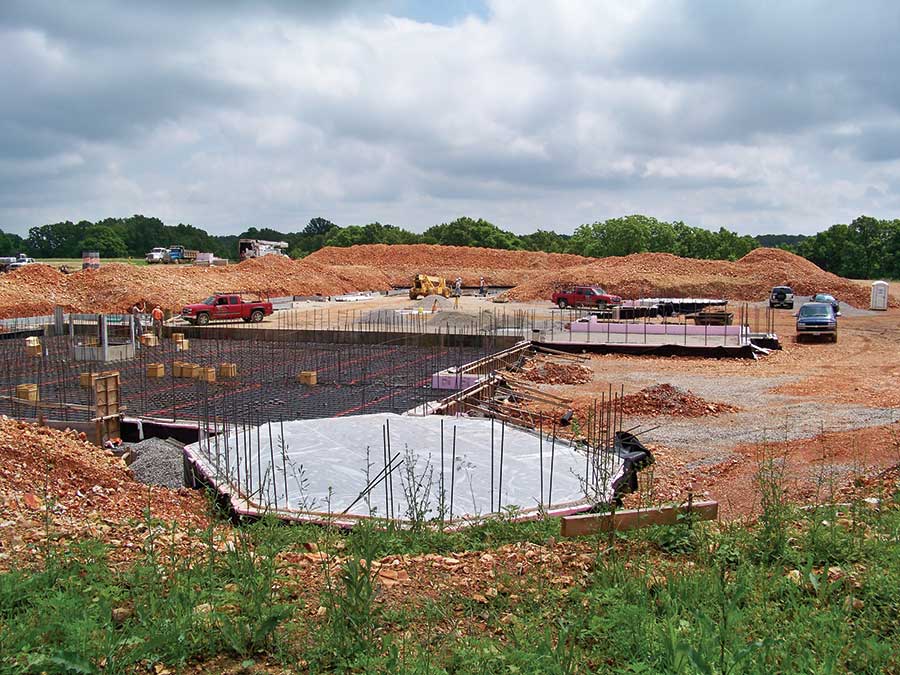Designed in the style of a French Chateau, Pensmore features an enormous 72,000 sq. ft. of living space on four levels. One of America’s Largest Homes Uses ICFs for Energy Efficiency, Disaster-Resistance
On a hilltop in southern Missouri, a massive construction project is underway. Begun in late 2010, the outside walls are now complete and the roof sheeted in, but crews estimate it won’t be ready for occupancy for another 18 months.
All of the exterior walls were formed with ICFs, so the industry is receiving considerable attention as part of the national media buzz. The project was covered in the New York Times and Good Morning America, as well as other national and regional media. Because of its size—a whopping 72,000 sq. ft.—and the owner’s business—he recently sold his firm that developed software for military and intelligence-gathering applications—speculation from neighbors about its intended purpose runs rampant. Some suggest it’s a military bunker; others propose it’s a nuclear shelter for VIPs, a reception facility for extraterrestrial visitors, or even a getaway for local boy Brad Pitt and Angelina Jolie.
 Owner Steven Huff dismisses those ideas as “goofy.” He says it’s just a second home, dubbed “Pensmore,” and he wanted plenty of room for friends and family. That shouldn’t be a problem, because Pensmore is one of the largest private residences in the country, with 13 bedrooms, 14 bathrooms and enough amenities to entertain a small city.
Owner Steven Huff dismisses those ideas as “goofy.” He says it’s just a second home, dubbed “Pensmore,” and he wanted plenty of room for friends and family. That shouldn’t be a problem, because Pensmore is one of the largest private residences in the country, with 13 bedrooms, 14 bathrooms and enough amenities to entertain a small city.
He says he picked the rural location because it’s just a short distance from where he grew up. Plus, he adds, there’s very little zoning and no mandated building inspections.
Huff discovered ICFs when researching building materials for the home. He was so impressed with the technology, and vertical ICF construction in particular, that after he chose TF Concrete Forming Systems as the ICF supplier, he bought a majority share of the company, and now serves as TF’s chairman of the board. He also redesigned the form for improved energy efficiency and to better accommodate the subcontractor trades. The new version is called TransForm.
Pensmore now doubles as a site to field-test cutting-edge technology on a commercial scale. Concrete cores are a full 12 inches thick, and reinforced with a steel fiber admixture. A combined nine inches of exterior and interior insulation means energy consumption will be relatively low. The home will be equipped to monitor interior temperature, energy consumption and heat collection to gauge its overall energy efficiency.

Quality products are used throughout the project, including Form-A-Drain footings and Platon, a dimple drain sheet which was used as an underslab barrier and on vertical below-grade surfaces.
The home site is not far from Joplin, Mo., scene of one of the nation’s most deadly tornadoes, so disaster resistance is also something designers incorporated.
Huff says the two major design requirements were energy efficiency and strength without compromising either for the other.
“We wanted to build a large home that can withstand tornado-force winds and demonstrate that similar designs can be built cost effectively and be applied to schools and other public buildings,” Huff says. “It’s not feasible to continuously demolish and rebuild structures over time. If you can construct a building that will last for more than a century, that greatly reduces your operational costs and stands as the true definition of sustainable. We tried to build Pensmore with building materials that would maximize its longevity.”
To maximize the quality of the footings and foundation, Huff chose CertainTeed’s Platon and Form-A-Drain products.
“I’d used Platon before on an addition to my current home and was impressed by it,” Huff says. “I wanted a good barrier underneath the slab foundation for protection from radon and to avoid moisture climbing up through the concrete. And, I wanted to try Form-A-Drain to see if having a leave-in foundation footing form would save us time and money, as well as take advantage of the product’s water and radon evacuation properties. Everything went well with the installation, and I look forward to seeing how well they perform after Pensmore is finished.”
The products were applied by Advanced Concrete Technology, Inc., a nearby foundation contractor. In fact, most of the construction has been done by local contractors that wanted to learn how to work with ICFs. Wall installation crews were a mix of local labor and experienced TF installers who were learning the finer points of building with the redesigned wall system.
“Any framing carpenter can learn and build with this product,” says Mary Guccione, director of marketing and communications for TF Systems. “Contractors comfortable with concrete forms use this product with ease as well.”
Significant sections of this French-style Chateau were panelized. As construction heights increased, it became common to build sections on the ground or on lower floors and hoist them into place with a crane.
Guccione reports, “TF Forming Systems set up an office in Ozark last year. Through the Pensmore project, TF has had the unique opportunity to talk to interested contractors, architects and building owners about the benefits of concrete and ICF construction, conversations that would have been more difficult had it not been for Pensmore. Once those people see the project in the building stage, they immediately understand the goal of building both residential and commercial structures that are hyper energy efficient and disaster resistant and they get excited. Everyone who sees it respects the goal and wants to support it.”
Project Statastics
Location: Highlandville, MO
Total building size: (sq. ft.) 72,000
Cost: undisclosed
Project Start-to-Finish Time: Begun 2010; ICF portion completed 2012; Project completion est. late 2013
Construction Team
Owner: Steven Huff
Architect: Owner/ Tom O’Neil (consulting architect)
General Contractor: Multiple
ICF Installer: Multiple
ICF System: TF Concrete Forming Systems









